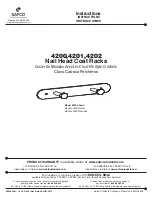
8
SEALING AND FASTENING
THE WINDOW (CONTINUED)
FIXED WINDOW REPLACEMENT
Improper screw depth, screw
head driven below the surface
of frame.
Proper screw depth, screw
head flush with surface of
frame.
E.
Finish driving all the installation screws through the wood frame jamb,
ensuring
the head of the screws is
flush
with the surface of the wood frame.
DO NOT drive screws below flush with the surface of the frame.
3D
3D
9
INTERIOR SEAL
Caution: Ensure use of low pressure polyurethane window and door insulating foams
and strictly follow the foam manufacturer’s recommendations for application. Use of
high pressure foams or improper application of the foam may cause the window frame
to bow and hinder operation.
8E
8E
4A
9A
A.
Apply insulation foam.
From the interior, insert the
nozzle of the applicator approximately 1" deep into
the space between the window and the rough opening
and apply a 1" deep bead of foam. This will allow
room for expansion of the foam and will minimize
squeeze out. If using insulating foam other than Great
Stuff™ Window and Door Insulation Foam by the
Dow Chemical Company, allow the foam to cure
completely (usually 8 to 24 hours) before proceeding
to the next step.
Note: It may be necessary to squeeze the end of the
tube with pliers to be able to insert into the space
10
EXTERIOR SEAL
A.
Insert backer rod
into the space
around the exterior of the window
at the head and jambs, deep enough
to provide at least a 1/2” clearance
between the backer rod and the
exterior face of the window.
Note: Backer rod adds shape and
depth for the sealant line.
3E
3E
10A
10A
between the new and existing window frame. DO NOT completely fill the space
from the back of the backer rod to the interior face of the opening.






























